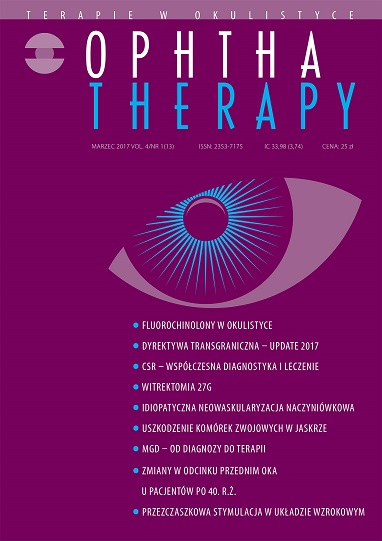Zmiany fizjologiczne w obrębie przedniego odcinka oka u pacjentów po 40. roku życia
##plugins.themes.bootstrap3.article.main##
Abstrakt
Zmiany zachodzące z wiekiem na powierzchni oka dotyczą jej wszystkich elementów i prowadzą do znacznych zaburzeń fi lmu łzowego, dyskomfortu oraz obniżenia ostrości wzroku. Wraz ze starzeniem się organizmu zmniejsza się wydzielanie łez, częściej występuje zapalenie oraz zwłóknienie przewodów gruczołu łzowego. W gruczołach Meiboma dochodzi m.in. do keratynizacji, zaniku meibocytów oraz do znaczących zaburzeń w produkowanej przez nie warstwie lipidowej fi lmu łzowego. Istotne zaburzenia powodujące niestabilność fi lmu łzowego związane są także ze zmianami hormonalnymi. Wraz z wiekiem obniża się wydzielanie hormonów płciowych, co skutkuje zaburzeniami pracy gruczołów powierzchni oka, a także maleje liczba nerwów w rogówce i następuje tzw. starzenie się układu immunologicznego. Zmniejsza się również liczba komórek śródbłonka rogówki. W niniejszym artykule opisano najczęstsze związane z wiekiem zmiany dotyczące powierzchni oka oraz rogówki.
Pobrania
##plugins.themes.bootstrap3.article.details##

Utwór dostępny jest na licencji Creative Commons Uznanie autorstwa – Użycie niekomercyjne – Bez utworów zależnych 4.0 Międzynarodowe.
Copyright: © Medical Education sp. z o.o. License allowing third parties to copy and redistribute the material in any medium or format and to remix, transform, and build upon the material, provided the original work is properly cited and states its license.
Address reprint requests to: Medical Education, Marcin Kuźma (marcin.kuzma@mededu.pl)
Bibliografia
2. Research in dry eye: report of the Research Subcommittee of the International Dry Eye WorkShop (2007). Ocul Surf. 2007; 5(2): 179-93.
3. Knop E, Knop N, Millar T et al. The international workshop on meibomian gland dysfunction: report of the subcommittee on anatomy, physiology, and pathophysiology of the meibomian gland. Invest Ophthalmol Vis Sci. 2011; 52(4): 1938-78.
4. McGill JI, Liakos GM, Goulding N et al. Normal tear protein profiles and age-related changes. Br J Ophthalmol. 1984; 68(5): 316-20.
5. Roszkowska AM, Colosi P, Ferreri FMB et al. Age-related modifications of corneal sensitivity. Ophthalmologica. 2004; 218(5): 350-5.
6. Niederer RL, Perumal D, Sherwin T, McGhee CNJ. Age-related differences in the normal human cornea: a laser scanning in vivo confocal microscopy study. Br J Ophthalmol. 2007; 91(9): 1165-9. https://doi.org/10.1136/bjo.2006.112656.
7. Sullivan DA. Tearful relationships? Sex, hormones, the lacrimal gland, and aqueous-deficient dry eye. Ocul Surf. 2004; 2(2): 92-123.
8. The epidemiology of dry eye disease: report of the Epidemiology Subcommittee of the International Dry Eye WorkShop (2007). Ocul Surf. 2007; 5(2): 93-107.
9. Yu J, Asche CV, Fairchild CJ. The economic burden of dry eye disease in the United States: a decision tree analysis. Cornea. 2011; 30(4): 379-87.
10. Berlau J, Becker HH, Stave J et al. Depth and age-dependent distribution of keratocytes in healthy human corneas: a study using scanning-slit confocal microscopy in vivo. J Cataract Refract Surg. 2002; 28(4): 611-6.
11. Schimmelpfennig BH. Direct and indirect determination of nonuniform cell density distribution in human corneal endothelium. Invest Ophthalmol Vis Sci. 1984; 25(2): 223-9.
12. Sperling S, Gundersen HJ. The precision of unbiased estimates of numerical density of endothelial cells in donor cornea. Acta Ophthalmol (Copenh). 1978; 56(5): 793-802.
13. Azen SP, Smith RE, Burg KA et al. Variation in central and vertical corneal endothelial cell density in normal subjects. Acta Ophthalmol (Copenh). 1981; 59(1): 94-9.

